#AIDS Coalition to Unleash Power (ACT UP)
Explore tagged Tumblr posts
Text



ACT UP
11 notes
·
View notes
Text
Yesterday was Long COVID Awareness Day. Glad to see ACT UP NY (Instagram outlink) being in solidarity with Long COVID survivors.
Way too many queer folks forgot (links to a zine) about the HIV/AIDS denialism in the '80s and '90s.
If you're interested in agitprop posters designed based on old HIV/AIDS awareness campaigns (Wikimedia outlink), Anna, aka X/@_copy_of_a_copy, has a series of "ACT UP/MASK UP" posters (Google Drive outlink) along with a long list of resources. mx. papaya (Carrd outlink) created a series of "Where is your RAGE?" posters and "CDC Kills" (Google Drive outlinks). Cohost/@edania has also produced a few posters here and here.
#COVID-19#SARS-CoV-2#long COVID#long COVID Awareness Day#long haulers#COVID long haulers#COVID-19 long haulers#AIDS Coalition to Unleash Power#ACT UP#COVID pandemic#AIDS pandemic#AIDS crisis#HIV activism#AIDS activism#disability rights#COVID resources#SARS-CoV-2 resources#COVID-19 resources#agitprop#queer solidarity
13 notes
·
View notes
Text
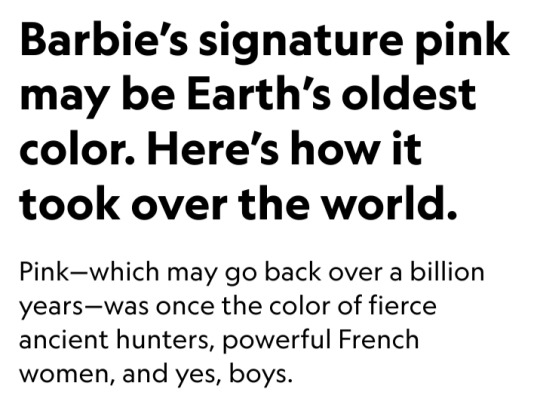

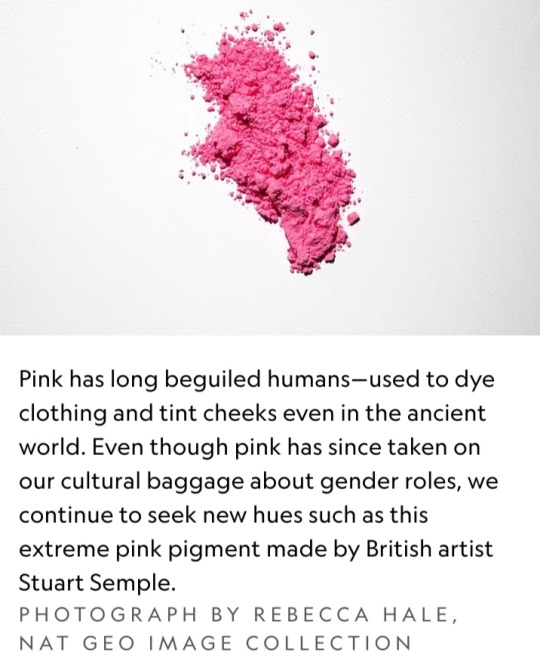
Could pink be Earth’s oldest color? That’s the implication of a 2018 study that found bright-pink pigments in 1.1 billion-year-old rocks — thanks to the fossils of the billions of tiny cyanobacteria that once dominated oceans.
The natural world has long been painted with every permutation of pink — whether embedded deep in ancient rock, sported by shrimp-hungry flamingoes, or simply lining the shores of Bermuda’s pink-sand beaches.
And yet the color carries a lot of cultural baggage.
As pink made the jump from nature’s palette to human adornment, it gathered connotations of colonialism, beauty, power, and gender.
How did pink become such a cultural flashpoint? As the world takes a revitalized interest in the hot-pink planet inhabited by Barbie, here’s a short history of the compelling color.
Admiration for pink in the ancient world
Early humans quickly transitioned from admiring pink in the natural world to attempting to wear it.
For example, in the Andes Mountains about 9,000 years ago, fierce hunters in what is now Peru wore tailored leather clothing with a pink hue thanks to red ochre, an iron oxide pigment that is one of the oldest natural pigments used by humans.
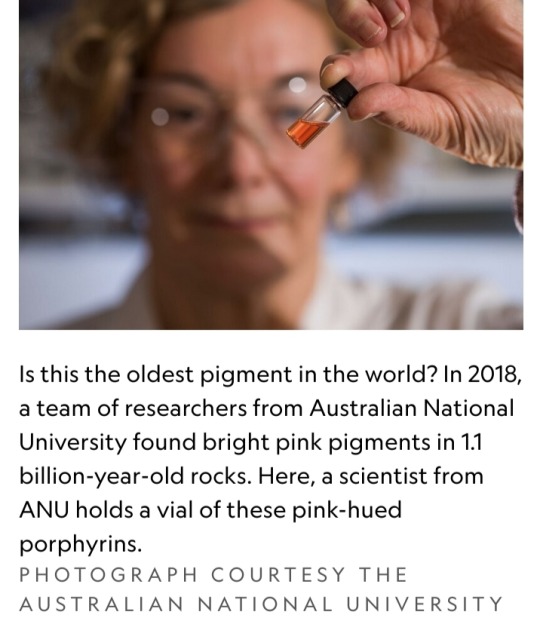
Humans weren’t content just to smear this pigment on cave walls or use it while tanning their leather garments.
As far back as ancient Egypt, humans used ochre to tint their lips and cheeks.
When applied to human skin, the red pigment created a blush-like pink that onlookers associated with love, sexuality, and beauty.
Lookalike concoctions prevailed around the world, employing everything from crushed strawberries to red amaranth.
The color of cosmetics—and colonialism
Though the word’s etymology is unknown, the word “pink” was used to describe the color in the 18th century.
By then, pink had become inextricably tied with colonialism — as demand for the pigment for cosmetics drove Europeans to harvest natural resources in other parts of the world.
For example, in a bid to make pinkish pigments from the bark and red sap of brazilwood trees, European traders forced enslaved workers to cut down so many of Brazil’s eponymous trees that the country was left deforested and the tree nearly driven extinct.
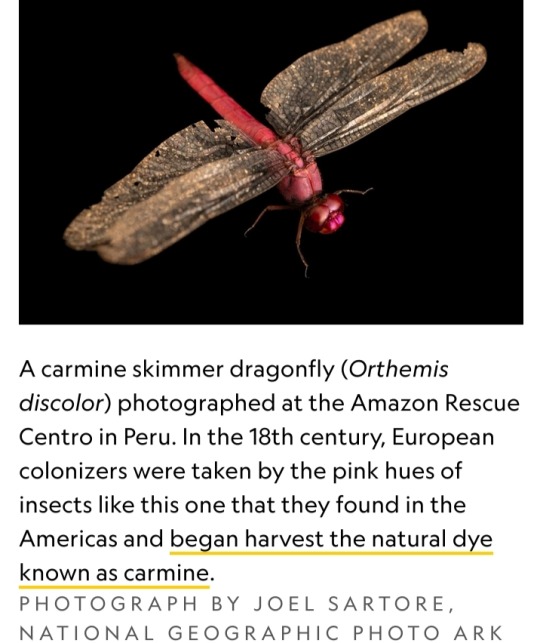
During this Era of Exploration, consumers also got their pink cheeks and lips from other pigments like carmine, derived from cochineal insects harvested in Central and South America under similar conditions.
Meanwhile, the color also had a more literal association with colonialism:
During this time, the British Empire grew so massive that the color pink — which mapmakers used to mark its territories worldwide — dominated the world map.
Pink becomes a bona fide fashion craze
As red tints became more accessible and cheaper, 18th-century European aristocrats indulged a passion for pink.
Art historian Michel Pastoureau writes that “the most privileged classes of European society wanted pastels, halftones, and the newest innovations in color shades in order to distinguish themselves from the middle classes, who now had access to bright, strong, and reliable colors.”
Madame de Pompadour, the mistress of Louis XV of France during the 1740s and 1750s, used the color as a signature.
The artists who painted her and created fine objects for her many homes used pink in all their designs, even her carriages, and she helped further popularize the hue throughout Europe.
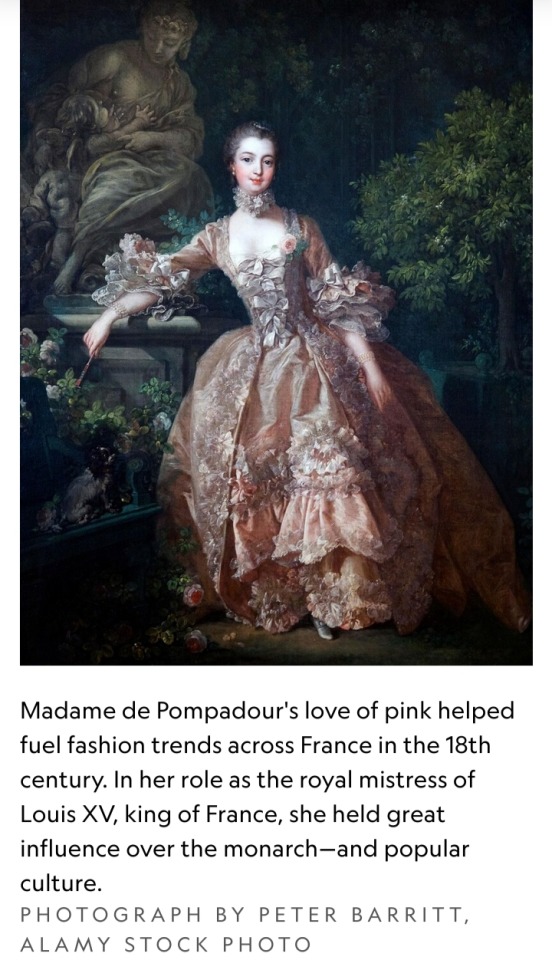
The emergence of synthetic dyes in the mid-19th century — which gave rise to the purple-pink color known as mauve — made pink more accessible than ever before.
By the 1930s, bright pink had become a bona fide fashion craze.
Avant-garde fashion designer Elsa Schiaparelli made “shocking pink” her signature color, helping spread the vogue for women’s wear.
It worked: By 1935, even local newspapers like the News and Observer in Raleigh, North Carolina, were declaring that “PINK IS FAVORITE.”
And in 1939, a royal commentator wrote in London’s Daily Telegraph that pink was so popular, it was nearly ubiquitous for both bridesmaids and debutantes.
“So general is the pink craze,” the paper wrote, “that some women are rebelling against it.”
Pink is for…boys?
Around the same time, pink gained relevance in another realm: baby fashion.
Gender and baby fashion had intersected for years; around World War I, etiquette guides and fashion advice columns began advising that mothers dress their children in clothing with gender-specific hues.
But which colors? A 1927 retailer survey on infant clothing colors published in TIME shows a split nation, with retailers like Filene’s and Marshall Field’s recommending pink for boys, but Macy’s, Bullock’s, and others claiming pink was best for girls.
By the 1960s, however, mothers began buying pink clothing for their female babies, dressing their male children in pastel blues.
“None of this transition happened by childcare expert fiat or industry proclamation,” writes historian Jo B. Paoletti.
Instead, pink gained steam as a signifier of a baby’s female sex as part of a post-World War II push to reinforce traditional gender roles in American homes — and the realization by retailers that they could make more money that way.
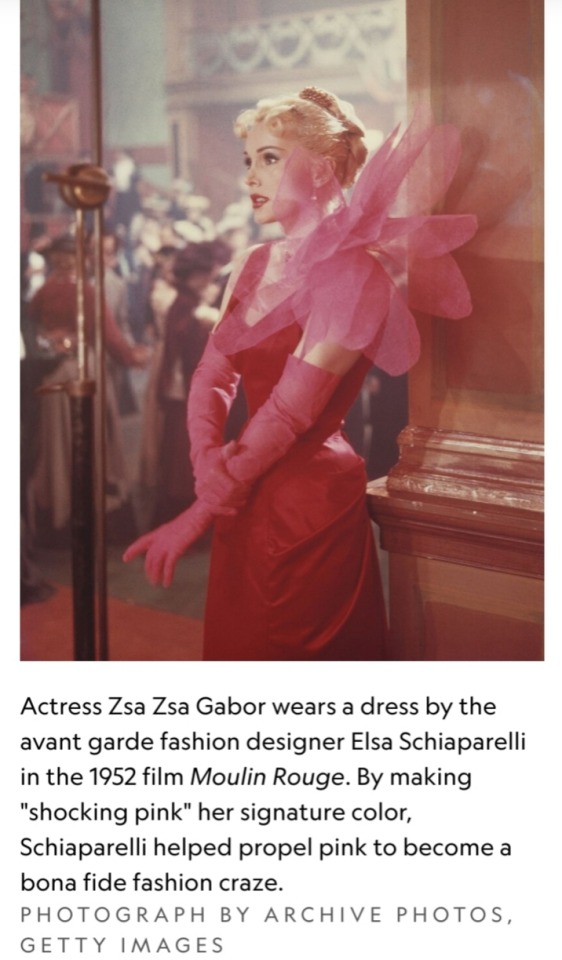
“The more baby clothing could be designed for an individual child — and sex was the easiest and most obvious way to distinguish babies — the harder it would be for parents to hand down clothing from one child to the next, and the more clothing they would have to buy as their family grew,” Paoletti writes.
Soon, retailers featured entire “pink aisles” packed with pink-colored clothing and toys for tiny consumers.
The dark side of pink
Pink was also rejected by some as a symbol of weakness or even sinister intent.
In Nazi Germany, for example, the color was used to brand gay men in concentration and death camps.
As the Cold War emerged, suspected Communist sympathizers were given the derogatory name of “pinkos” — a term that referred to a person with “red” tendencies toward radical politics.
Meanwhile, members of the women’s liberation movement attempted to distance themselves from a color that had become inextricably linked with femininity and sexuality — think: Marilyn Monroe slinking down a staircase in a shocking pink gown, surrounded by tuxedoed men.
Anti-feminists, meanwhile, embraced pink.
Author Helen B. Andelin, for example, made public appearances in all-pink ensembles in the 1960s and 1970s during lectures encouraging women to abandon feminism and embrace lives as housewives.
Reclaiming pink
Pink remains associated with femininity to this day — but in recent decades, groups once disdainfully branded with the color have made moves to reclaim it.
In the LGBTQ community, for example, people who were once forced to wear pink as outcasts have adopted the hue as a symbol of their movement for social justice.
In 1987, the AIDS Coalition to Unleash Power (ACT UP) adopted a bubble-gum pink triangle in its “Silence = Death” campaign to increase awareness of HIV-AIDS and destigmatize the disease.
It was just one example of pink being used to represent gay pride.
Some feminists have also reclaimed the color, fighting gender stereotypes with a tongue-in-cheek adoption of all shades of rose, fuchsia, and bubble-gum pink.
At the 2017 Women’s March, for example, a sea of protesters wearing pink, cat-eared “pussy hats” protested the inauguration of U.S. President Donald Trump, whose lewd remarks about female genitalia during a leaked interview drew worldwide condemnation.
Today, pink is what you make of it — and it has grown in popularity once more.
In 2016, Pantone announced that a shade of dusty pink — dubbed Millennial Pink for the generation that had embraced it—was its Color of the Year.
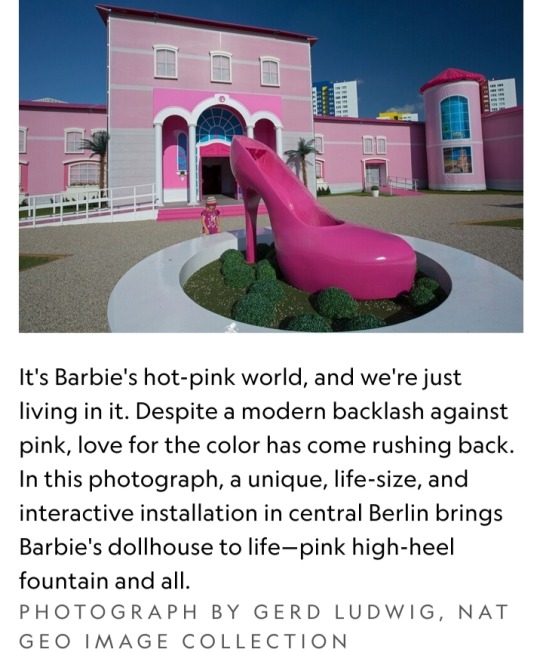
This year, Greta Gerwig’s upcoming Barbie movie helped fuel the rise of the pink-drenched “Barbiecore” aesthetic, inspiring admirers to saturate their homes and wardrobes with every shade of pink.
According to Axios, searches for the term “Barbiecore aesthetic room” rose over 1,000 percent between May 2022 and May 2023, reflecting consumers’ craving for as-pink-as-possible interiors.
There’s no telling which permutation of pink will captivate us next — but given the colorful history of the hues that fall somewhere between white and red, pink’s next heyday is probably right around the corner.

Barbie would approve of the pink petals on this beach morning glory.
Pink flowers like this one get their rosy tinge from a group of biological pigments called anthocyanins, which attract pollinators — and human admirers — to colors ranging from the palest carnation to the most ostentatious tropical fuchsia.
#pink#red ochre#carmine#Era of Exploration#Madame de Pompadour#Louis XV of France#mauve#Elsa Schiaparelli#gender#baby fashion#colors#Helen B. Andelin#AIDS Coalition to Unleash Power (ACT UP)#Pantone#Millennial Pink#Barbie#Nat Geo#fashion#political movement#Marilyn Monroe#Zsa Zsa Gabor#pigment
14 notes
·
View notes
Text

1989
amfAR establishes a Community-Based Clinical Trials (CBCT) program and awards grants to 16 research units.
The NIH funds 17 community-based AIDS clinical research units as part of a federally sponsored research program. As a result of CBCT trials, some funded by amfAR, the FDA approves treatments for AZT-induced anemia and Mycobacterium avium complex and a new method of preventing pneumonia.
Robert Mapplethorpe dies of AIDS.
amfAR staff member Bruce Kent dies of AIDS.
U.S. YEAR-END STATISTICS
117,508 cases of AIDS reported to date 89,343 deaths
1 note
·
View note
Text
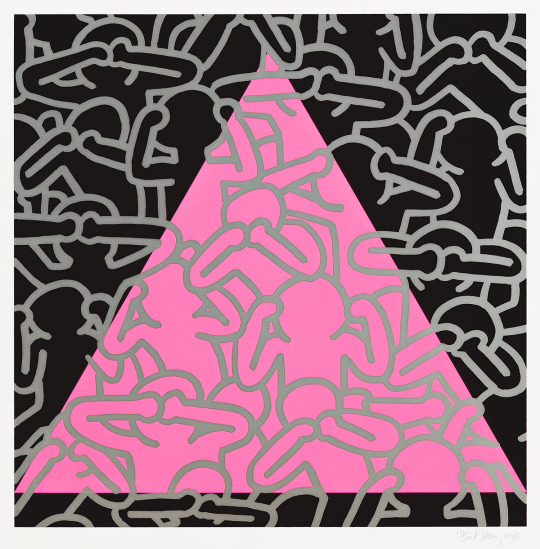
1989 Keith Haring “Silence = Death” 152/200
Haring was able to leverage his celebrity to support causes and activist groups, like ACT UP, the AIDS Coalition to Unleash Power. The sale of his art and merchandise, was among the first of the organization's sources of fundraising. The present screenprint, Silence = Death, was created by Haring as a fundraiser for the Arts Outreach Fund for AIDS, using ACT UP's slogan and iconic pink triangle, which was originally used by the Nazis to identify and persecute homosexuals. The logo was created by the art collective, Silence = Death Project, co-founded by artist and activist Avram Finkelstein, in 1987 as a poster campaign. The logo was later donated to ACT UP, of which Finkelstein was also a founding member.
[source: Swann Galleries]
928 notes
·
View notes
Text
happy pride from them xoxo
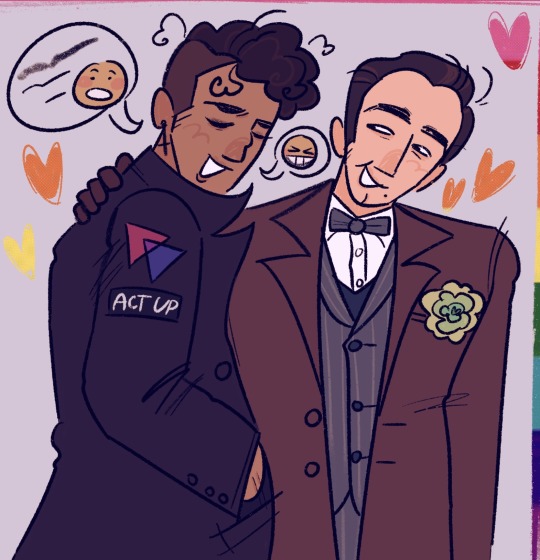
BIANGLES
The biangles were designed by activist Liz Nania in 1985 in order to represent bisexual pride. Using a pink triangle to represent homosexuality, a blue triangle to represent heterosexuality, and a purple overlap to represent queerness. The color purple, or lavender, was commonly associated with queerness through flower language and the lesbian radical feminist group Lavender Menace. The pink triangle was also already a popular symbol of queerness. Originally used to mark gay men and trans women in Nazi concentration camps, the symbol was later reclaimed as a symbol of queer pride/power during the HIV/AIDS epidemic. The biangles most likely inspired today’s bi flag.
ACT UP
ACT UP or the AIDS Coalition to Unleash Power is a political activist group formed in 1987 with the goal to raise awareness for and better the lives of those living with HIV/AIDS.
GREEN CARNATION
Popularized by 19th century gay author Oscar Wilde, wearing a green carnation on one’s left lapel became a symbol of homosexuality among queer men.
#emory scribbles#dead boy detective netflix#dead boy detectives#edwin payne#charles rowland#paynland#dbda#paineland
275 notes
·
View notes
Text
Pride 2025 Day 2: Larry Kramer (1935-2020)
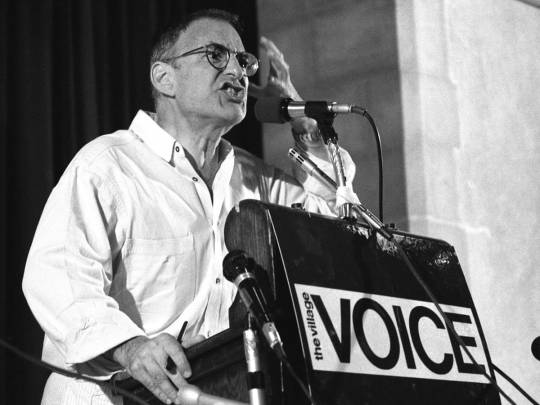
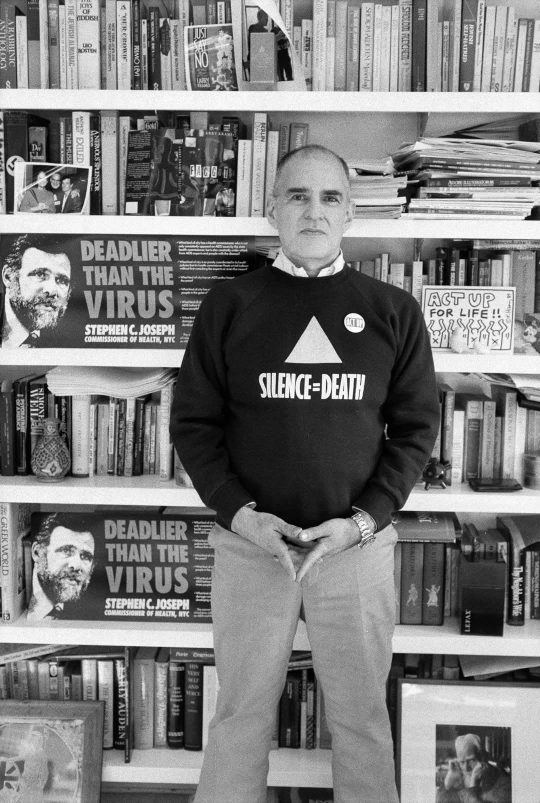
Larry did an immense amount of work for AIDS advocacy. He was a highly acclaimed gay Jewish screenwriter, playwright, and author. In the '80s as he couldn't just sit by and watch his friends die while the government did nothing. He first founded the Gay Men's Health Crisis (GMHC), which has gone on to provide more in home care for individuals with AIDS than any other private organization. Realizing that political action was needed to get the government to address the AIDS crisis he left GMHC and founded AIDS Coalition to Unleash Power (ACT UP). ACT UP organized massive political protests including their infamous Die-Ins, where protesters lied down with signs in the shape of tombstones. ACT UP's Die-Ins disrupted Wall Street multiple times and forced the US Government to act. In 1988 after years of advocating for AIDS related causes he was diagnosed with HIV, which he survived for decades until passing from pneumonia in 2020. May we remember the two organizations he founded, one for service and one for advocacy, and go forth with a similar two pronged approach!
23 notes
·
View notes
Note
portrait of ross in la?
Oh, I do not feel comfortable rating this one or searching for any eroticism in it.
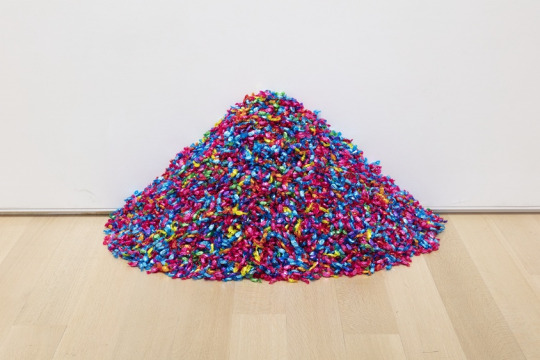
This is a piece of art inspired by the death of Ross Laycock, the lover of artist Felix Gonzalez Torres, during the AIDS crisis.
Ideally this piece is 175lbs of candy (corresponding to an average body weight of an adult man). Throughout the day, pieces are taken and taken. Like Ross, it wastes away, and viewers are left with the anticipation of loss.
This piece genuinely makes me feel like my heart has been ripped from my chest. I want to wail with grief when I think about it too long.
Instead of a review, I humbly offer up, for your elucidation and viewing pleasure, relevant works.
Check out the others works of Felix Gonzalez Torres, they're very moving.
Electric Fan (Feel It Motherfuckers): Only Unclaimed Item from the Stephen Earabino Estate by John S. Boskovich, a thematically similar piece of art. It also brings me to tears when I see it.
Let the Record Show by Sarah Schulman, which is based on...
The ACT UP Oral History Project, a project that seeks to preserve the history of the AIDS Coalition to Unleash Power and their activism through the AIDS Crisis.
United in Anger a film by Jim Hubbard, a documentary on ACT UP
If plays or films are more your style, I recommend Angels in America by Tony Kushner. My favorite version is the 2003 TV series from HBO. It stars Justin Kirk, and it is genuinely uplifting and gut wrenching all at once.
If anyone else has pieces of art they suggest, please, feel free to reblog with them! I think art is one of the best ways sometimes to engage with historical atrocities like this. Whether that art is fictionalized or factual, it connects us like nothing else.
Let yourself learn about this and let yourself feel things about this.
#AIDS crisis#tagging that for people's filters because i understand this is a fraught subject for so many#Unreviewed#Felix Gonzalez Torres#art review
125 notes
·
View notes
Text
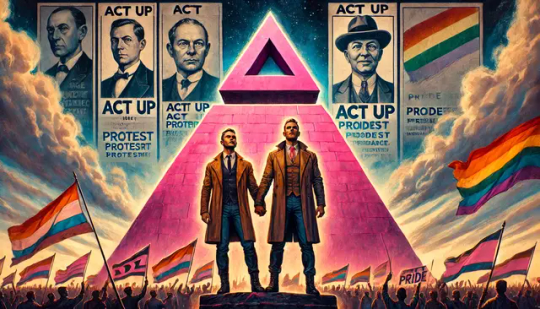
The Power of People
"The AIDS Coalition to Unleash Power (ACT UP) is a diverse, nonpartisan group of individuals, united in anger, and committed to direct action to end the AIDS crisis. This means we focus on HIV/AIDS and closely-related issues. Many of our members are also involved in other types of activism or activist groups, but ACT UP recognizes the importance of staying focused on HIV/AIDS until there is no longer an epidemic."
#metamorphicmuse#dall e#ai image#ai male#gay art#handsome male#ai artwork#male beauty#ai art#masculine#protest#advocacy#organizing#health#hiv aids#act up#gay#ai art challenge#pink#pride month
10 notes
·
View notes
Note
Hi there.
Reaching out to let you know that I'm very, very much looking forward to reading 'No Letting Go'.
If I'm not mistaken I found your blog / this particular writing project when I came across another fan's post highlighting Daniel's book (A Shadow on the Skin) on Kaposi's sarcoma and the beginnings of the AIDS epidemic. Since then, I've been searching for meta - and specially fic - that explores Daniel's experience with the AIDS crisis, given that he not only reported on it but engaged in some high risk behavior (having sex with men for drugs, for one) during that time.
So I'd appreciate anything that you may wanna share regarding this specific plotline, if something of the sort is indeed to be featured in "No Letting Go".
Hiya @gardinha! 🤗 Thank you so much for reaching out with such a fantastic question! Honestly, there's so much I want to share that it was quite challenging for me to write this response!

At its core, “No Letting Go” is about intergenerational trauma in various forms, and I think it’s fair for me to say that no event has marred the collective queer psyche quite like the HIV/AIDS Crisis—and I think that, even in today’s era of PrEP, there remain aspects of that crisis that the queer community has yet to fully reconcile or "let go" of. To me, Daniel Molloy is a character who could embody much of this trauma, and could allow me to explore some of the impacts of the Crisis on individual and collective memory.
But where to begin?
AMC's "Interview With the Vampire" begins by positioning Daniel Molloy within the context of the COVID-19 pandemic.
And so I began with Larry Kramer.
Larry Kramer—who passed away in early 2020 from pneumonia while under lockdown and working on a new play titled "An Army of Lovers Must Not Die," which reportedly was intended to be about "gay people having to live through three plagues" (the third being aging)—was an AIDS activist. As a co-founder of the Gay Men's Health Crisis (the largest provider of resources to AIDS patients US-wide) and the grassroots activist group AIDS Coalition to Unleash Power (ACT UP), Kramer's impact on both the community and public health advocacy was profound.
During the recent COVID-19 pandemic, Kramer notably re-entered the public conversation, his name being often brought up in conjunction with Dr. Anthony Fauci. Fauci, who first became the director of the National Institute of Allergy and Infectious Diseases in 1984 during the initial surge of the AIDS crisis—who has been a key figure in managing both the HIV/AIDS and COVID-19 health emergencies.
During the initial outbreak of the COVID-19 pandemic, I experienced an interesting discourse emerge in the queer leftist communities that I am a part of.
On one hand, there was a tangible, unified commitment across the community to prevent the spread of COVID-19. This collective resolve was directly fuelled by a desire to avoid the devastating losses similar to those experienced during the AIDS crisis. The phrase "remember AIDS?" frequently echoed within the community, serving as both a cautionary reminder and a rallying cry to ensure history did not repeat itself. This sentiment strengthened the communal effort to protect each other and highlighted a profound awareness of shared historical trauma.
But simultaneously, there was also a notable scepticism towards government health organizations like the CDC, a sentiment deeply rooted in the community's experiences during the AIDS crisis, when the government's response was notoriously inadequate. This distrust was further complicated by the fact that Dr. Anthony Fauci, a central figure during both the AIDS crisis and the COVID-19 pandemic, headed these responses. The prevailing sentiments of "do not trust the CDC" and "don’t trust Fauci" resonated strongly within the community. (Ironically, these were the same slogans being adopted by anti-mask right-wing groups during the pandemic, highlighting a complex layer of shared mistrust that originated from very different motivations and historical contexts.)
This dichotomy, to me, really exemplified the ongoing impact of historical trauma on the contemporary queer community.
And so I took this back to Daniel Molloy for “No Letting Go.”
Starting in Act II—(Act I is set in a different historical moment that also cannot be “let go” of)—Daniel and Armand are deeply entrenched in the cultural and political fabric of the queer community during the early stages of the AIDS crisis, from 1981 to 1985. This period is captured through a mix of "more objective" flashbacks (though true objectivity is intentionally subverted, aligning with the narrative style of "Interview With the Vampire”) and the personal reflections of Daniel and Armand. The era, characterized by ambiguity and a nascent understanding of AIDS, offers a backdrop not just for exploring fear but more significantly, the political dynamics of the time.
My focus on the AIDS Crisis in “No Letting Go” is on how the community organized, responded, and survived rather than on the pervasive fear, using Daniel (who, perhaps, did not survive—according to the book canon) as a means of exploring this.
In "No Letting Go," Daniel Molloy in 1981-1985 is a still-human journalist living with Armand in their New York City apartment. Unlike a vampire, Daniel is deeply embedded in the community and its internal politics, which naturally sets the stage for tension between him and Armand, given their differing existential perspectives and capabilities. (But we won’t get into that for right now…)
The backdrop to Daniel's life during this period includes the 1978 publication of Larry Kramer's novel "Faggots," which Daniel sees as profoundly damaging to the community—and a personal attack on both Armand and himself. Kramer wrote "Faggots" to critique what he perceived as self-destructive and hedonistic behaviours prevalent within certain segments of the gay community—precisely the segments that Daniel is a part of. Kramer’s vocal support for monogamy and his stance against group sex, cruising, anonymous encounters, bathhouses, glory holes, BDSM, and the usage of both street and prescription drugs directly conflict with the lifestyle and freedoms cherished by Daniel and Armand.
So, in “No Letting Go,” I wanted to set Daniel in relation to the AIDS Crisis based on his stance within the broader discourse of queer liberation and the politics of barebacking. Daniel's animosity towards Kramer not only stems from their opposing views on sexual freedom but extends to Daniel rejecting the safer sex practices Kramer advocated—such as limiting partners, abstinence, or condom use (things which would prove to be keys to survival during the AIDS Crisis). Daniel's perspective on AIDS is framed by his perception of Kramer as an adversary to his personal freedom.
Why should Daniel heed warnings from someone who opposes so much of what defines his community and personal identity?
To end with a content warning (just one of the many things in “No Letting Go” that earns it its place on @devils-minion-cult ‘s Devil's Minion Freak4Freak Porn AO3 list) please be aware that "No Letting Go" includes scenes set during the AIDS Crisis, depicted from Daniel’s perspective with an implicit element of bugchasing: the eroticisation of HIV. For Daniel, this is a natural progression of his established inclination to find sexual thrill in life-threatening scenarios. His tendency to eroticise elements that possess the potential to be lethal translates into a profound sexual stimulation derived from engaging in high-risk sex. And engaging in unprotected sex with a partner who could potentially be HIV positive represents the ultimate risk.
#interview with the vampire#iwtv#daniel molloy#devil's minion#armand/daniel#armandaniel#No Letting Go#ok to reblog#meta
28 notes
·
View notes
Text

On December 10, 1989, a significant event in New York City would set the stage for Ray's remarkable journey. Thousands of activists, many living with AIDS themselves, gathered for the "Stop The Church" demonstration outside St. Patrick's Cathedral. Their target: Cardinal John O'Connor, an influential Catholic authority whose statements on homosexuality, abortion, and AIDS had sparked outrage. O'Connor, despite being appointed to Ronald Reagan's AIDS commission in 1987, controversially claimed that condoms were only 50% effective at preventing HIV transmission.
Led by AIDS Coalition to Unleash Power (ACT-UP) New York, the "Stop the Church" direct action made international headlines and introduced the activist group to mainstream consciousness. Amidst this historic event, a queer, HIV-positive visionary named Ray Navarro boldly declared, "Make sure the second coming is safe - use condoms!"
youtube
Ray Navarro's became a member of ACT UP New York in 1988. Known for their bold, innovative, and powerful organizing in demanding greater attention, research, and resources for people living with AIDS, ACT UP marked the beginning of Ray’s tireless advocacy for those affected by HIV/AIDS.
For the 1989 "Stop the Church" protest, Ray masterfully incorporated performance art by dressing as Jesus Christ. He reclaimed this religious figure, which had been weaponized against queer and HIV-positive people by Cardinal O'Connor, as a radical savior who believed in safer sex and HIV prevention.
Ray was also a founding member of DIVA TV (Damned Interfering Video Activists), a collective of artists who used multimedia to document the work and history of ACT UP. They ensured that police violence during protests, often ignored by mainstream media, was captured and preserved.
Ray's dedication extended to the Latinx LGBTQ+ community, where he recognized the unique challenges faced by individuals affected by AIDS. His bilingual activism bridged gaps and ensured that vital information and support reached this community.
Ray's performance art, challenged stereotypes and misconceptions surrounding AIDS and LGBTQ+ identity. In 1990, after losing his vision to AIDS-related illness, Ray collaborated with artist Zoe Leonard to create the photographic series "Equipped." This project centered on disabled people, shedding light on the complexities of disease, race, class, and sexuality.
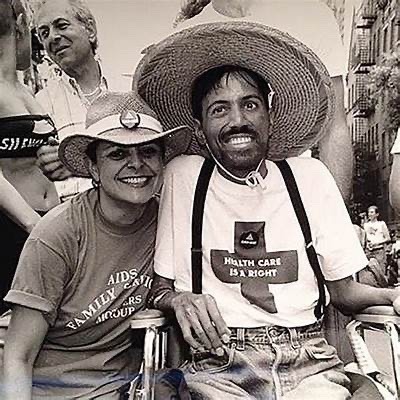
Ray Navarro died from complications due to AIDS in November 1990 when he was just 26 years old. His passing was a devastating loss to the LGBTQ+ community and the broader AIDS activist movement. However, his legacy endures through his art, performances, and activism, inspiring subsequent generations of activists and artists.
Ray Navarro's life, art, and activism challenged stigma, demanded justice, and helped change the trajectory of the AIDS crisis. Today, we remember him not only as an AIDS activist but also as a pioneering artist and a fearless advocate for LGBTQ+ rights and visibility so that someone like myself could exist, breathe and thrive. His legacy testifies to the resilience and strength of all people living with HIV and AIDS.
19 notes
·
View notes
Link
It Was Vulgar and It Was Beautiful by Jack Lowery: In the late 1980s, the AIDS pandemic was annihilating queer people, intravenous drug users, and communities of color in America. Out of the activist group ACT UP (AIDS Coalition to Unleash Power), an art collective that called itself Gran Fury formed to campaign against corporate greed, government inaction, stigma, and public indifference to the epidemic. ..... View the full summary and rep info on wordpress!
#dailybook#disabled#gay#HIV#mlm#NonFiction#queermisc#queerrep#2020s#400pg#adultbooks#art#health#history#lgbtnonfiction#lgbtqia#maleprotagonist#nonfiction#queerbooks#QueerLiberationLibrary#time1980s
5 notes
·
View notes
Text

The front page of a June 5, 1987 newsletter from Northwestern Memorial Hospital in Chicago with information about a series of lectures and films on AIDS. For context in terms of the time line here, the group ACT UP (the AIDS Coalition to Unleash Power) formed on March 24, 1987.
6 notes
·
View notes
Text
Queer Protest Photos
Content Warnings: HIV/AIDS, homophobia, medical violence against intersex people, use of a slur in an organization’s name
Finally found some time to actually select and compile the ones I wanted to include in this post. I have well over 200 pictures I’ve digitally collected over a span of approximately 5 years. I’ll try to include some information (when possible) about each one as well!
(2 important notes: information is only that which I have been able to verify, therefore dates or locations may be omitted. As well the genders of people in the photos is assumed for the descriptions.)
A Die-In, San Francisco. Date currently unverified
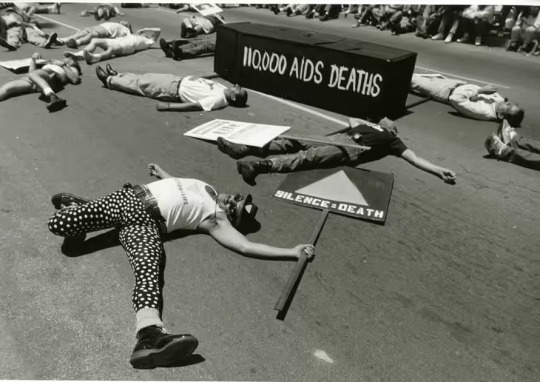
(Photo description: A black and white photo of several people lying on a city street as if they’re dead. In the front is a man holding a sign with a triangle and the slogan “Silence = Death”, behind him is another man with an unreadable sign, in the middle is a large coffin which says “110,000 Deaths”)
Die-ins were a common form of protest during the AIDS Crisis in which groups of people would gather and lay down in public places as if they were dead. This is a picture of one which occurred in San Francisco most likely in the 1980’s.
ACT-UP Protest, Grand Central Terminal, NYC. Jan. 24, 1991
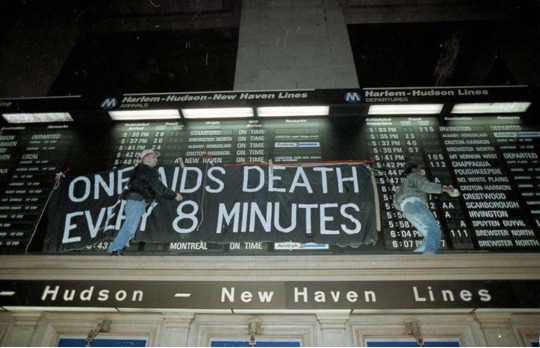
(Photo Description: A colour photo taken from below of two men standing on a train station timetable sign. They are hanging a black and white sign with a small red border which reads “One AIDS Death Every 8 Minutes”. The sign is partially obscured by one of the men)
ACT-UP, or the Aids Coalition to Unleash Power, was a prominent political organization working to bring an end to the AIDS epidemic. This photo was taken during the placement of a large banner at Grand Central Terminal in New York City bringing awareness to the fact that at this time there was approximately one death from AIDS every 8 minutes.
People of Colour Mobilizing Against AIDS. April 1st, 1989
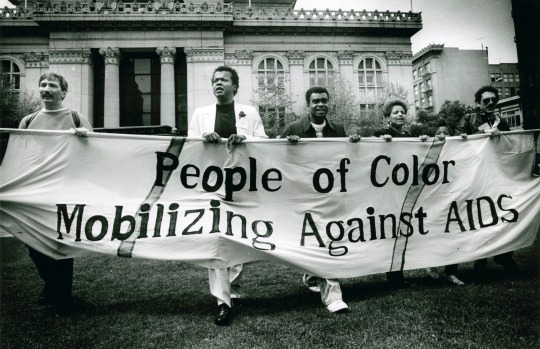
(Photo Description: A black and white photo of 6 people holding up a very large black and white banner which reads “People of Color Mobilizing Against AIDS”, the banner has grey stripes on it. There are 2 men of unknown ethnicity on wither side of the banner, in the middle are two black men and 2 black women. One of the black women is almost entirely hidden behind the banner with only the top half of her face showing)
Likely taken at a college campus. Often photos surrounding AIDS protests leave out one of the groups most vulnerable to AIDS: people of colour. I think this photo is an amazing reminder that people of colour were a massive part of the fight to end AIDS
The Stonewall Riots, NYC. June 28, 1969
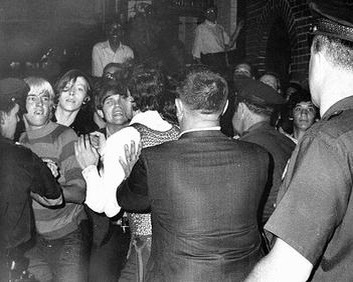
(Photo Description: A black and white photo of several teenage boys and young men scuffling with men in suits and police officers. The photo is crowded with people. The boys at the front are being pushed back by the police officers)
This is the only known photo taken of the riots at the Stonewall Inn. It was taken on the first day of the riots by Joseph Ambrosini. It shows the chaos that occurred during the police raid on The Stonewall Inn.
Notable Queer Activists At A March. Date and location not currently verified.

(Photo description: a black and white photo of people walking down a city street. Some of them are holding signs. There’s an older woman with light curly hair and a man with short dark hair and a large mustache in the front. They’re talking to each other and the man is holding a white cassette recorder. They’re wearing black shirts with triangles and the slogan “Silence = Death”)
This is a photo most likely taken in the late 1980’s of notable queer activist Connie Norman. I’ve seen the person beside her referenced as being Robert Birch but I have yet to find a young photo of him in order to verify. In the background another notable gay activist (although he was unfortunately also a NAMBLA activist) Harry Hay can be seen. This photo was taken at an AIDS protest.
Mother and Son, San Francisco. June, 1984
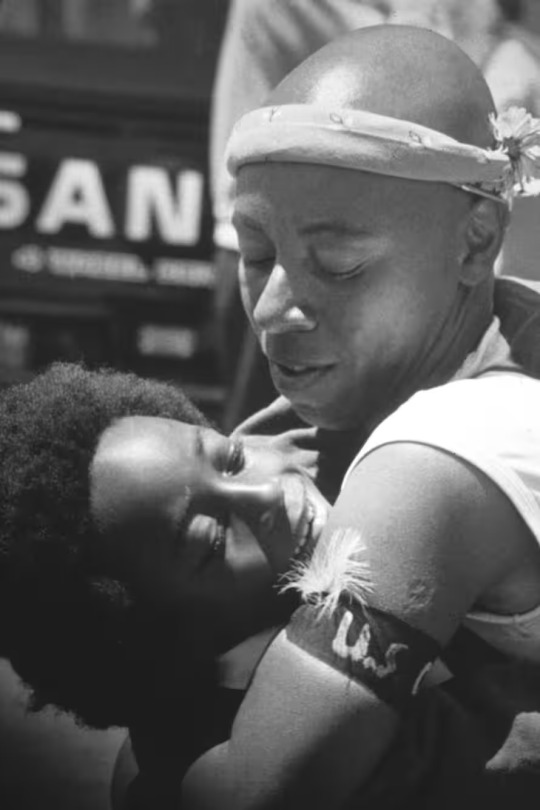
(Photo Description: a black and white photo of an African American mother and son embracing each other. The son has an armband with a feather. He is also wearing a rolled bandana around his head with a flower tucked into it. )
This photo is believed to have been taken by Joan E. Biren. While it’s not what’s often imagined when one thinks of a “protest photo”, this photo was taken at a 1984 Pride march which was certainly a protest. The people in this picture were members of a queer marching band called Sistah Boom. The people on the photo are often referenced as mother and son but whether that’s true I do not know.
Men Embracing At AIDS March, NYC. August 12, 1984

(Photo Description: A black and white photo of two men standing in front of a group of people marching. The group has 3 signs with slogans. One is unreadable, the others say “Stop AIDS Not Gays” and “Fight AIDS Not Gays”. The two men in front are both wearing black trench coats and one has his arm wrapped around the other’s waist. They’re facing away from the camera)
This photo is interesting because it appears on the New York City AIDS Memorial. This photo was taken as a protest surrounding the AIDS Crisis and I think that the inclusion of the men embracing makes it incredibly heartwarming.
A Father Holding A Sign, Westchester, New York. September 12, 1974
<Warning! Brief mention of homophobic violence!>

(Photo Description: A black and white photo of an older man in a suit holding a large handmade sign which reads “I’m proud of my gay son”. He is standing in front of a crowd of people. There is a banner being held by members of the crowd in the background which reads “Gay Liberation of Westchester”. )
This photo was taken at a Gay Liberation March in 1974. It shows Dick Ashworth marching in defense of his son. This photo was taken shortly after the formation of Parents of Gays which later became FLAG or P-FLAG. This photo was taken shortly after the son of the found of Parents of Gays was beaten in a homophobic attack.
The First Modern Intersex Protest, Boston, MA. October 26, 1996
(Content Warning: Brief mention of forced surgery on intersex people, use of a slur in the name of an organization)
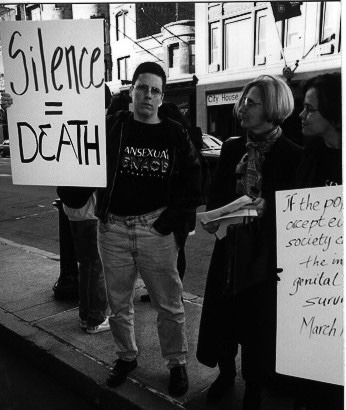
(Photo Description: a black and white photo of people standing on a traffic island in the middles of the road holding signs. There is a man with short dark hair and glasses holding a sign which reads “Silence = Death”. Next to him are two women. The background contains light coloured buildings)
This photo contains intersex advocate Max Beck at the first ever modern protest for intersex rights. Max Beck is a notable intersex advocate who’s sex was indeterminate at birth but forced to undergo surgery and was raised as a female . This photo was taken at a protest organized by Hermaphrodites With Attitude, an organization which sought to end the human rights violations against intersex people. This photo means a lot to me personally as an intersex person.
I have so many more I wish I could show but for the sake of the length of this post I’ll only include one more. The most famous by far…
If I Die Of Aids…, 1988

(Photo Description: A colour photo taken from behind of a man wearing a custom painted dark coloured jacket. A finger partially obscures the picture. The back of the jacket reads “If I die of AIDS — Forget burial — Just drop my body on the steps of the F.D.A”, behind the text is a large pink triangle)
You almost certainly have seen this photo before but you may not know the story behind it. This picture was taken of queer artist David Wojnarowicz during a protest in 1988 regarding the F.D.A’s failure to properly handle the AIDS crisis. David Wojnarowicz had been diagnosed with HIV only one year prior to this photo being taken.
This isn’t even scratching the surface. I have so many more pics that include many many different types of queer people and subject matters. I wish I could share all of my photos and maybe I’ll make more posts like this in the future. I’ll see how this one does before I make any promises.
And to all my queers out there: stay safe. I love you. We’re family. Take care of yourself, if not for you than for our ancestors in these photos. And for the sake of taking more photos which will one day be considered “queer history”. We have always been here and we will always be here even if people try to break our spirit. 🏳️🌈🏳️⚧️❤️🧡💛💚🩵💙💜🌸🌼🌺🪻
#gay#mlm#queer#trans#lgbt#lgbtq#lgbtqia#lgbt history#lgbtq history#pride#hiv/aids#wlw#lesbian#bi#pan#pansexual#bisexual#transgender#cw homophobia#cw aids#long post
10 notes
·
View notes
Text
“IF I DIE OF AIDS- FORGET BURIAL- JUST DROP MY BODY ON THE STEPS OF THE F.D.A.”.
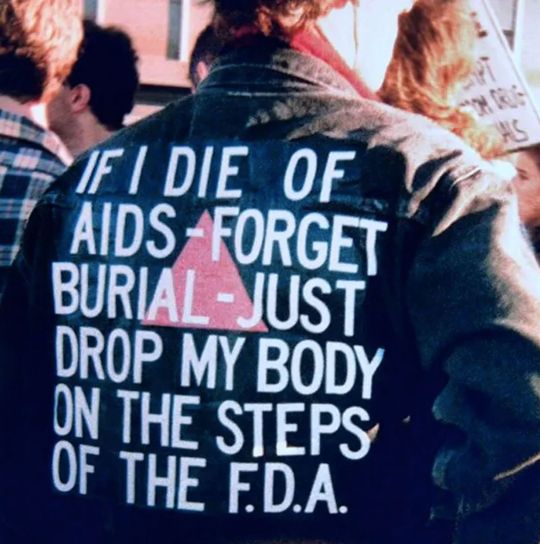
In the year 1988, American artist David Wojnarowicz (1954-1992) \ tested positive for HIV and began a new phase of his life attending ACT UP meetings and demonstrations in New York and Washington. He and partner Tom Rauffenbart then created an affinity group of ACT UP with Zoe Leonard known as “The Candelabras”. In June of that year David created AIDS Memorial Quilt panels “David creates AIDS Memorial Quilt panels to honor his friends Peter Hujar and Keith Davis for The Names Project’s AIDS quilt displayed in Central Park. (The David Wojnarowicz Foundation)”
On October 11th, 1988 was pictured partaking in the ACT UP protest in front of the FDA headquarters in Rockville, Maryland. At this widely televised protest, David is pictured in a jacket stating, “IF I DIE OF AIDS- FORGET BURIAL- JUST DROP MY BODY ON THE STEPS OF THE F.D.A.”. The organization ACT UP was founded a year prior on March 12th, 1987, and stands for the Aids Coalition to Unleash Power. This demonstration, “Seize Control of the FDA”, took place in response to the lack of action by the FDA when it came to “its slow drug-approval policy which resulted in thousands dead from lack of access to life-saving drugs. (ACT UP Oral History Project)”
David passed of HIV/AIDS-related illness at his home on July 22, 1992 at the age of 37. At his funeral a banner stating “DAVID WOJNAROWICZ, 1954–1992, DIED OF AIDS DUE TO GOVERNMENT NEGLECT.” was carried around The East Village of New York City. In October 1996, his partner Tom scattered his ashes on the White House lawn as part of ACT UP’s Second Ashes Action.
Photo Credits: David Wojnarowicz at ACT UP FDA demonstration, Rockville, Maryland, October 11, 1988. Photo by Bill Dobbs. NYU Downtown Fales Collection.
5 notes
·
View notes
Text
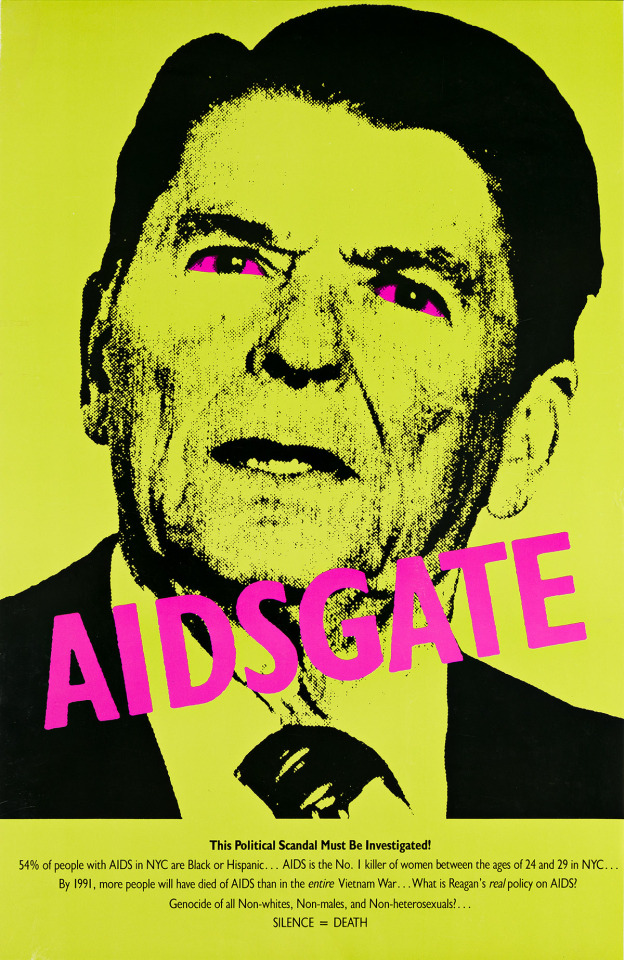
Aidsgate, Silence=Death Collective. 1987. 34”x22” lithograph poster. AIDS Coalition to Unleash Power [ACT UP]
This was the first poster designed after the Silence=Death Collective joined with ACT UP. "The image for [this poster] was always a fait accompli: there was no controversy over whether to depict Reagan. We chose an image of him that would translate into a one-color graphic, flattening him into iconography that could be easily recognizable from a distance and on television B roll, the images used to illustrate voiceover news reports" (After Silence p. 72).
18 notes
·
View notes